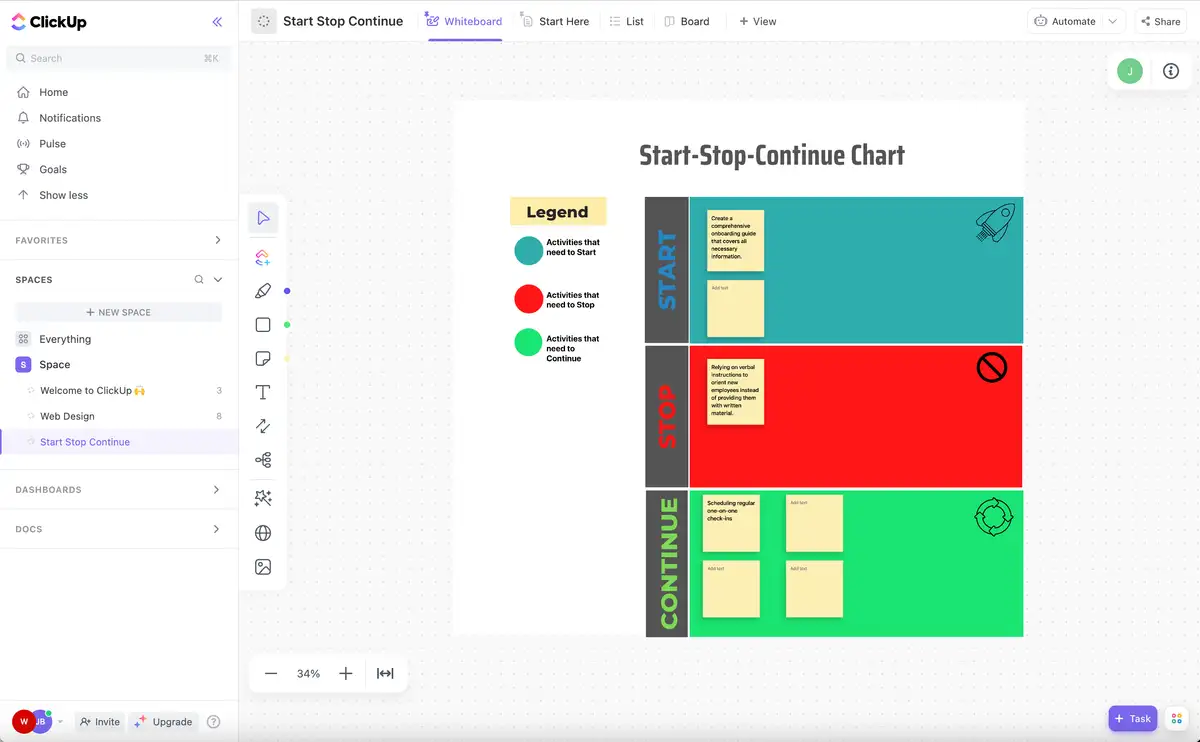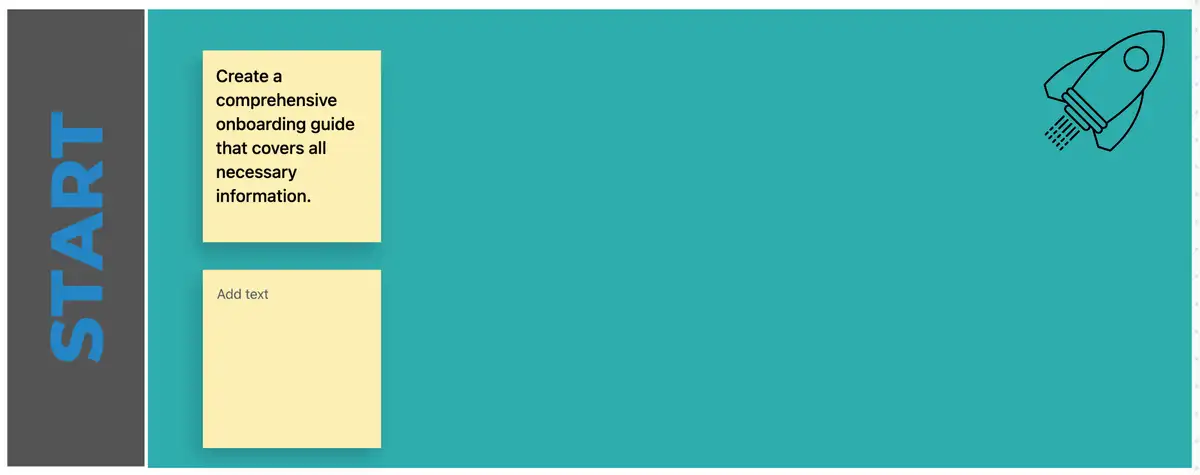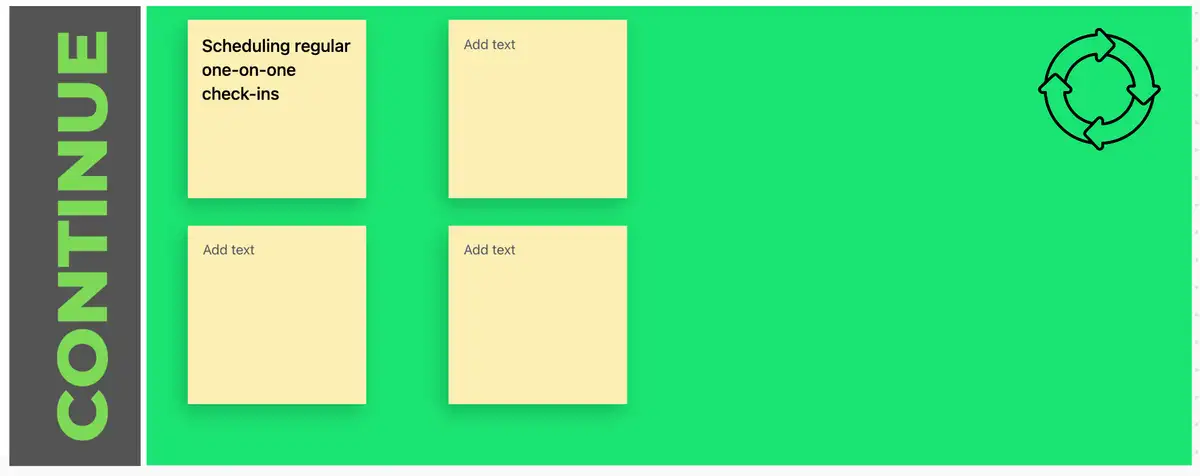The basic elements of a Start-Stop-Continue chart.
Each column is intended to encourage the user to reflect on what activities should start, stop, or continue in order to achieve any desired outcomes.
For, let's tkelk a how Start-Stop-Continue can help with customer analysis. Say you want to improve customer satisfaction ratings, you might what activities should start (e.g., offering more personalized service), what activities should stop (e.g., using automated emails for customer support), and what activities should continue (e.g., providing for customers).
By taking time to reflect on what activities should start, stop, or continue, managers and employees alike can gain insight into areas that may need improvement and further align their efforts wthe company’s desired outcomes.
also provide a visual representation of progress, allowing project teams to accurately monitor progress, identify opportunities for improvement, and celebrate successes.
Not only that, but it also helps you visualize provides a visual representation of the effectiveness of current activities and processes, allowing teams to quickly address problem areas, recognize successful strategies, and/or create internal incentives.
And it can help improve how you and your team communicate by encouraging open dialogue between team members and giving everyone has an opportunity to contribute their ideas and suggestions.
In a nutshell, Start-Stop-Continue charts make a positive impact by helping
- Identify areas of improvement and successes
- Encourage self-reflection or organizational review
- Provide a visual representation of progress
- Allow teams to accurately monitor progress
- Identify opportunities for improvement
- Celebrate successes
Business use cases for Stop-Start-Continue charts.
Now that you know why to use a Stop-Start-Continue, it's time to figure out when you should put it to work. The good news is that these charts for virtually any business use case! Here are just a few examples of how you might use one:
- Improving customer service practices
- Increasing employee engagement
- Creating a process strategy to improve efficiency and productivity
- Developing an effective team management strategy
- Streamlining the software development process
- Finding areas to boost profit margins
- Identifying new marketing opportunities
- Improving time management practices
- Developing a strategy to reach new customers
- Reducing the impact of workplace silos
- Lowering overall operating costs
Follow these helpful instructions to make an effective Start-Stop-Continue chart:
- Identify your main goal.
When creating your Start-Stop-Continue chart, it’s important to clearly
define the goal or outcome you want to achieve. This will help inform the activities and processes you should include on the chart. A good example of a goal you can use this chart for is "improve the onboarding experience for new hires."
where your team can collaborate on determining a goal and collect real time feedback.
- Create
Once you’ve zeroed in on the goal, create three rows: Start, for business activities you and your team think you should begin to implement; Stop, for activities and/or processes that you think are no longer useful and should cease; and Continue, for practices that have proven successful and you should keep sticking to them.
This template automatically creates the rows for you—but it's easy to do yourself, too. Use a Whiteboard and in ClickUp to make an interactive visual chart with start, stop, and continue columns.
Pictured: The Start row in ClickUp.
- Brainstorm activities.
Have a brainstorming session where you ask your team to come up with a list of activities, processes, ideas, initiatives, etc. that you currently are or aren't doing.
- Giving new hires a comprehensive onboarding guide that covers all necessary information
- Relying on verbal instructions to orient new employees instead of providing them with written material
- Scheduling regular one-on-one check-ins
Pictured: The Stop row in ClickUp.
- Assign goals.
Once the
brainstorming is finished, put your listed activities in the row you think they should go. Using the list above, it may look something like this:
Start: Giving new hires a comprehensive onboarding guide that covers all necessary information
Stop: Relying on verbal instructions to orient new employees instead of providing them with written material
Continue: Scheduling regular one-on-one check-ins
Then, you want to refine your goals based on what you've decided to start, stop, or continue. In this example, new goals you may consider are collecting and recording all the information that used to be conveyed verbally, and then turning it into an engaging and easy-to-read guide.
Create Lists or tasks in ClickUp based on the goals you've assigned to each activity.
Pictured: The Continue row in ClickUp.
- Collect feedback, review, and revise.
Once the list is complete, collect feedback from your team, review the chart and make any necessary changes. This is a key step because Start-Stop-Continue charts can consistently evolve based on new information. Keeping flexibility in mind and allowing for revisions throughout the process will be helpful to test what's working and what can be improved.
Set an automated task in ClickUp to review and revise your goals so your can keep them updated as your work evolves.
- Take action.
Finally, get to work on the action items listed in your Start-Stop-Continue Chart to ensure that you reach your desired goal. In this case, you can create an action plan by assigning a team member to collect important new hire information and another team member to use that research to write the guide.
Assign specific tasks to your team in ClickUp to make sure everyone knows what they should be working on.
Key takeaway.
The Start-Stop-Continue chart is an important tool for any team looking to improve processes or deliver better work. It helps you review their current activities and identify what should be done, stopped, or continued to more effectively reach your goals.
With this Start-Stop-Continue chart template in ClickUp, you can quickly identify what activities are helping your team or holding them back—and then figure out what you can do to better set them up for success.
Related Templates











